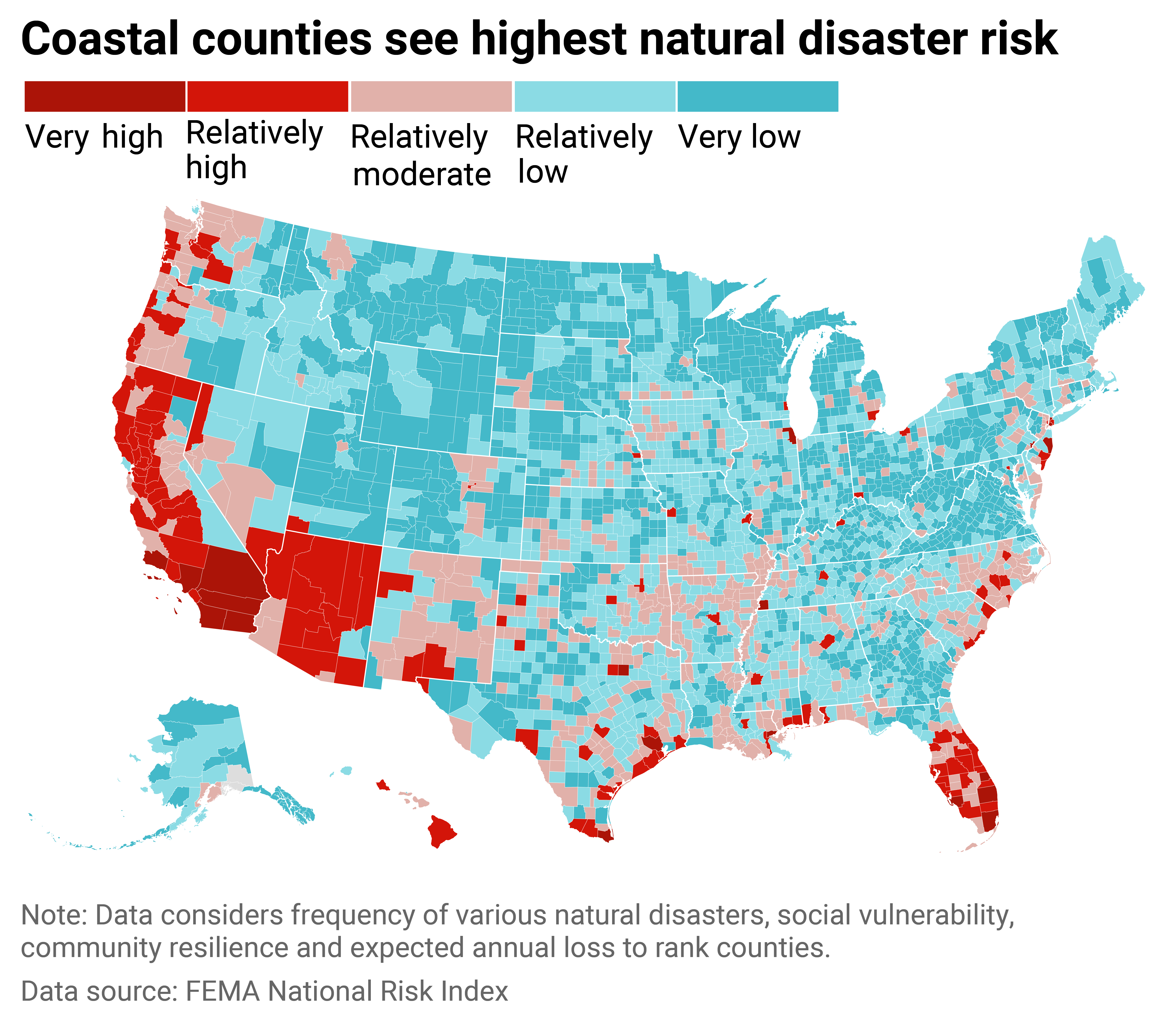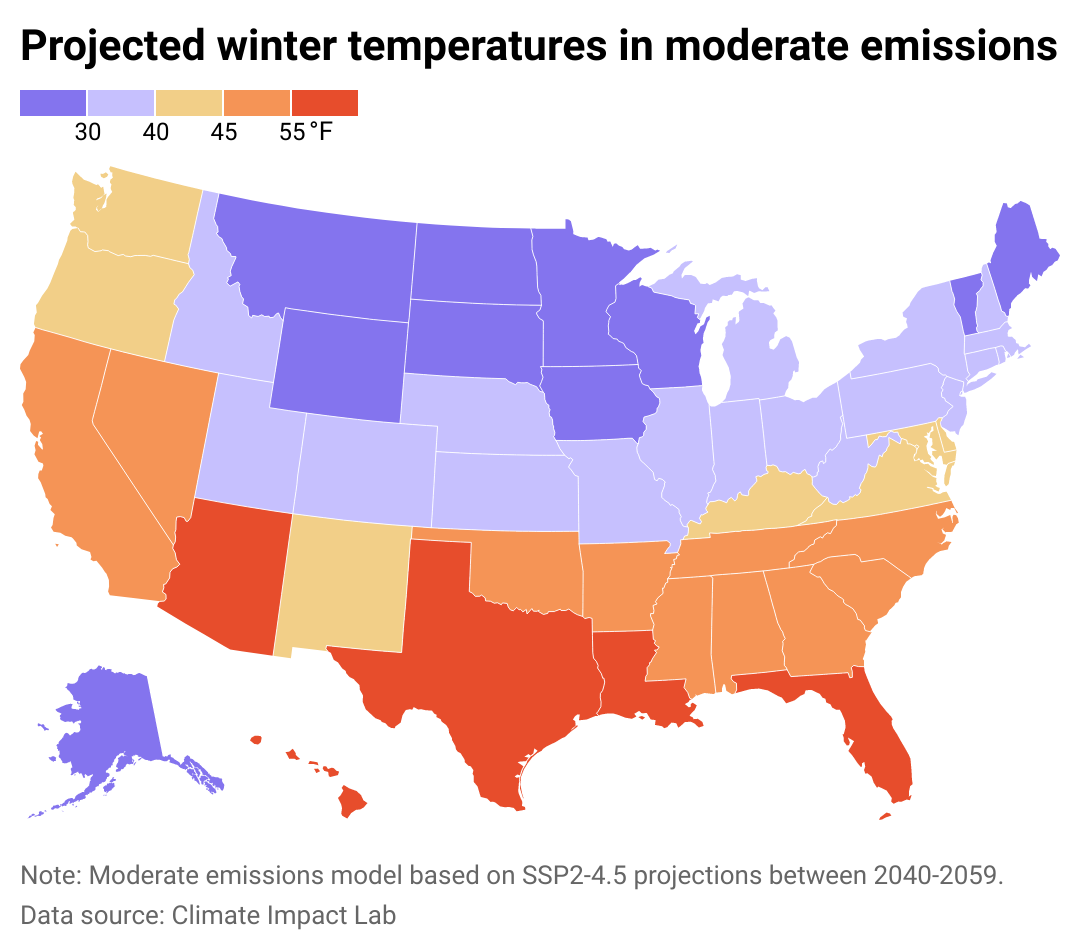Will coastal regions still be safe locations for snowbirds in 2050?
SchubPhoto // Shutterstock
Will coastal regions still be safe locations for snowbirds in 2050?
Large pastel homes on the beach.
Retirement is a dream for many Americans, especially if it includes a house along the coast or a seasonal residence located in a warmer, sunnier climate—the ultimate reward for a lifetime of hard work. But today, more than ever, retirees must factor in the current and potential future impacts of climate change when deciding where to spend their sunset years.
Currently, scientists don’t have comprehensive data about the scale of America’s climate migration—which is when people leave an area due to climate-driven factors such as drought, flooding, and other adverse environmental changes. There also isn’t definitive data on sea-level rise, though local data suggests it is already underway. Researchers across various disciplines—including health care, economics, and the environment—all agree that migration, particularly inland and northward, will become more common.
A 2023 report from Moody’s Analytics forecasts out-migration from states including Arizona, Florida, South Carolina, and New York—all of which are popular with retirees—due to sea-level rise and extreme heat. Outbound migration from certain states means inbound migration to others, including those in the Rocky Mountain, Midwest, and New England regions.
A separate study conducted by Jesse Keenan, an associate professor of real estate in the architecture school at Tulane University, predicts similar movements. Using information from the National Ocean Service’s 2022 Sea Level Rise Technical Report, Keenan estimates 50 million Americans could move due to climate change, many even within the next 30 years, to climate havens like the Upper Midwest.
It is important for retirees to understand the immediacy of the impacts of climate change in some regions. In an interview with Stacker, Josh Willis, a climate scientist at NASA and leader of the Oceans Melting Greenland mission, noted that our perception of climate change as an eventual, far-off, or incremental reality is not always true. Extreme weather events—like those which have historically happened once every 100 years but now happen once every 10—are forcing Americans to deal with the impact of climate change now, not someday in the future.
“We like to think that it’s a sort of slow-moving thing, that we’re going to see it coming but actually, no,” Willis told Stacker. “We experience climate change in the teeth of these extreme events all at once.”
Florida has long dominated lists ranking the best places to retire, thanks to its beaches, warm weather, and financial benefits. Florida has no state taxes on retirement income like Social Security, pensions, IRAs, and 401(k)s. This fact alone may tempt retirees to overlook the climate risks in favor of greater financial well-being. But doing so could still cost them in the long run.
People willing to accept the dangers of extreme weather may face difficulties obtaining and protecting their hard-earned retirement properties. An increase in the number and intensity of climate-driven natural disasters means insurance companies are paying out more in claims. Unsustainable rates of insurance payouts may lead insurance companies to deem some regions uninsurable, which may make it difficult to secure mortgages on those sought-after properties.
Because Market cited data from the Federal Emergency Management Agency and the Climate Impact Lab to look at climate risks across the country, and what shifting warmer temperatures could mean for retirees as they seek snowbird destinations.
![]()

Because Market
Popular retirement destinations are already high risk
Map of natural disaster risk at the county-level.
Sea-level rise is one of the largest threats to communities that are historically popular with retirees, particularly along the coasts of California, Florida, and the Carolinas, and it’s happening at a record rate—more than double what it was 30 years ago, according to Willis.
One-third of the sea-level rise happening today is actually due to sea-level expansion from trapped greenhouse gasses produced by humans, not just more water entering the oceans as a result of melting ice.
“We think of global warming as [just] the air warming, but over 90% of it is happening in the oceans. So really our planet’s having ocean warming, and everything else is a consequence of that ocean warming,” Willis said. “When seawater warms, it literally expands and takes up more space, and this extra space it takes up causes sea levels to rise. We talk about these numbers for sea-level rise in inches. It’s a few inches over a few decades. But an inch of sea-level rise can cause 8 or 10 feet of beach loss.”
According to the Environmental Protection Agency, roughly 20 square miles of land were lost to sea-level rise along the Atlantic Coast between 1996 and 2011, with the Southeast coast losing significantly more than the mid-Atlantic. A 2022 analysis by Climate Central found that nearly 650,000 individual, privately owned properties across more than 4 million acres of land are projected to fall below changing tidal boundaries within the next 30 years. Impacted acres could double to 9 million by 2100, with the Atlantic and Gulf Coasts bearing most of the loss.
“I think our vacation spots are definitely headed inland … headed for higher ground, let’s say,” Willis predicts.
Extreme heat is also a significant repercussion of climate change—and this is of notable impact for older populations, who are more susceptible to heat-related illness. By 2050, popular retirement locations like Miami and Phoenix, for example, could have more than 100 days a year where temperatures exceed 100 degrees Fahrenheit. Buffalo, New York, a potential climate haven, on the other hand, might experience only eight such days a year.

Because Market
Shifting warmer temperatures could make new areas appealing
Map of projected temperatures at the state-level under moderate emissions. All states see increases in temperatures.
The Midwest and Northeast will see the greatest winter temperature increases by the mid-21st century (2040-2069), likely due to a combination of factors including increased temperatures and decreased snow cover. While this could possibly make certain places more tolerable to snowbirds, winters in those regions will remain the coldest in the country.
Cities like Buffalo, Milwaukee, Pittsburgh, and Duluth, Minnesota, are among those named by experts as potential climate havens. These regions are less likely to experience extreme, acute weather events like flooding, hurricanes, and wildfires. However, this does not mean they are spared from other risks like drought, heat waves, cold snaps, or unpredictable winters.
Willis notes that despite nationwide warming temperatures, snowbirds will still have unpleasant weather to run away from. “Winters are getting more unpredictable and more severe at the same time,” he said. “Even though the planet is warming, arctic blasts that blow snow over a huge chunk of the states are actually getting worse. As the Arctic warms, some of that cold air is getting pushed to the south and really punishing us.”
This story originally appeared on Because Market and was produced and
distributed in partnership with Stacker Studio.
